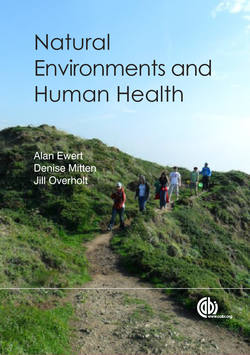Читать книгу Natural Environments and Human Health - Alan W Ewert - Страница 11
На сайте Литреса книга снята с продажи.
Underlying Assumptions
ОглавлениеThis book has a foundational assumption that interaction with the natural world is most often a positive, health-enhancing experience. While some literature discusses potential negative outcomes from interaction with natural environments (Andrews and Gatersleben, 2010; Bruni et al., 2012), the vast majority of research and scholarship supports the overall assumption in this book that natural environments can provide health-promoting experiences and behaviors for individuals and groups (Johansson et al., 2011; Kline et al., 2011). For example, Russell (2003) and Mitten (1994) propose that therapy done in natural settings can be effective in creating more positive and health-enhancing behaviors. In addition, Ewert and Galloway (2012) and Mitten (2009) suggest that programs such as those that are adventure-based can provide opportunities for achieving health and wellness within society. In a similar fashion, O’Brien et al. (2011) draw connections between outdoor education and skills developed in woodlands and greenspaces and human health and well-being. In a socio-ecological approach to health, health results from an interwoven relationship between people and their environment. Natural environments play a key role in a socio-ecological approach to health because these environments encourage and enable people to relate to each other and the natural world (Maller et al., 2006). Along the same thinking, there are a number of theories and practices related to the restorative nature of natural environments, namely attention restoration, friluftsliv, and psycho-evolutionary connections, as discussed later in the book. We acknowledge that nature can be harsh; many environments because of their geographic location, including altitude, are inclement for humans. Storms, earthquakes, and volcanoes can have devastating effects; still nature is not evil or against humans. We are part of the global and perhaps cosmic ecosystem with both benign and catastrophic forces.
The second primary assumption made in this book is that the effects of natural environments upon human health can actually be felt, observed, and/or measured. Larivière et al. (2012) suggest that while experiences in natural environments often result in positive anecdotal accounts, a substantial amount of variation exists from a variety of empirically derived studies and perspectives. Understanding these potential and real outcomes is made even more urgent by authors such as Lyytimaki (2012) and Louv (2005) who believe that members of industrialized societies are becoming more alienated and separated from nature experiences and more accustomed to indoor and technology-oriented environments; they argue that this separation from nature has adverse effects on individuals’ health and well-being.
The third primary assumption is that in order for the natural environment to positively impact human health we need to care for the environment. With an understanding of our need for nature for health and well-being, people are more likely to be advocates to ensure environmental or ecological quality. People will have a deeper understanding of the human–nature connection and when we feel that on a visceral level we will develop a strong ecological conscience leading to positive action (see Chapter 8).
